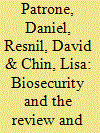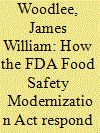|
|
|
Sort Order |
|
|
|
Items / Page
|
|
|
|
|
|
|
| Srl | Item |
| 1 |
ID:
126033


|
|
|
|
|
| Publication |
2012.
|
| Summary/Abstract |
Dual-use research of concern (DURC) is scientific research with significant potential for generating information that could be used to harm national security, the public health, or the environment. Editors responsible for journal policies and publication decisions play a vital role in ensuring that effective safeguards exist to cope with the risks of publishing scientific research with dual-use implications. We conducted an online survey of 127 chief editors of life science journals in 27 countries to examine their attitudes toward and experience with the review and publication of dual-use research of concern. Very few editors (11) had experience with biosecurity review, and no editor in our study reported having ever refused a submission on biosecurity grounds. Most respondents (74.8%) agreed that editors have a responsibility to consider biosecurity risks during the review process, but little consensus existed among editors on how to handle specific issues in the review and publication of research with potential dual-use implications. More work is needed to establish consensus on standards for the review and publication of dual-use research of concern in life science journals.
|
|
|
|
|
|
|
|
|
|
|
|
|
|
|
|
| 2 |
ID:
126086


|
|
|
|
|
| Publication |
2012.
|
| Summary/Abstract |
Despite the tragic accidents in Fukushima and Chernobyl, the nuclear power industry will continue to contribute to the production of electric energy worldwide until there are efficient and sustainable alternative sources of energy. The Chernobyl nuclear accident, which occurred 26 years ago in the former Soviet Union, released an immense amount of radioactivity over vast territories of Belarus, Ukraine, and the Russian Federation, extending into northern Europe, and became the most severe accident in the history of the nuclear industry. This disaster was a result of numerous factors including inadequate nuclear power plant design, human errors, and violation of safety measures. The lessons learned from nuclear accidents will continue to strengthen the safety design of new reactor installations, but with more than 400 active nuclear power stations worldwide and 104 reactors in the Unites States, it is essential to reassess fundamental issues related to the Chernobyl experience as it continues to evolve. This article summarizes early and late events of the incident, the impact on thyroid health, and attempts to reduce agricultural radioactive contamination.
|
|
|
|
|
|
|
|
|
|
|
|
|
|
|
|
| 3 |
ID:
126005


|
|
|
|
|
| Publication |
2012.
|
| Summary/Abstract |
Rapid public health response to a large-scale anthrax attack would reduce overall morbidity and mortality. However there is uncertainty about the optimal cost effective response strategy based on timing of intervention, public health, resources, and critical care facilities. We connected a decision analytic study to compare response strategies to a theoretical large scale anthrax attack on the Chicago metropolitan area beginning either Day 2 or Day 5 after the attack. These strategies correspond to the policy option set forth by the Anthrax Modeling Working Group for population-wide response to a large scale anthrax attack: (1) postattack antibiotic prophylaxix, (2) postattack antibiotic prophylaxis and vaccination, (3) Preattack vaccination with postattack antibiotic prophylaxis, and (4) preattack vaccination with postattack antibiotic prophylaxis and vaccination.
|
|
|
|
|
|
|
|
|
|
|
|
|
|
|
|
| 4 |
ID:
125972


|
|
|
|
|
| Publication |
2012.
|
| Summary/Abstract |
Recent cases of counterfeit and contaminated medication have raised concerns about the integrity of the US supply chain of pharmaceuticals. Moreover, Shortage in oncology drug have highlighted a weak domestic production capacity for essential medication. The FDA and the Pew Charitable Trusts have published analyses of the problem as they relate to the US's regulatory system and healthcare industry. These issues also represent a potential national security threat.
|
|
|
|
|
|
|
|
|
|
|
|
|
|
|
|
| 5 |
ID:
125990


|
|
|
|
|
| Publication |
2013.
|
| Summary/Abstract |
The FDA Food Safety Modernization Act (FSMA) significantly overhauled the statutory tools used by the Food and Drug Administration (FDA) to meet its public health mandate, many of which had not changed for more than 70 years. The law focuses on preventing foodborne illness but also strengthens the agency`s ability to detect and respond to food safety issues from any source. Although none of the food safety episodes that (at least in part) prompted the law`s passage resulted from acts of terrorism, Congress included in FSMA a number of provisions intended to address the threat that terrorism could pose to the food supply. This article introduces 4 of those provisions, discusses the status of each one`s implementation, and offers a recommendation for addressing a major impediment to effective implementation of the law.
|
|
|
|
|
|
|
|
|
|
|
|
|
|
|
|
| 6 |
ID:
126029


|
|
|
|
|
| Publication |
2012.
|
| Summary/Abstract |
In this article, we analyze feedback from simulated casualties who took part in field exercises involving mass decontamination, to gain an understanding of how responder communication can affect people's experiences of and compliance with decontamination. We analyzed questionnaire data gathered from 402 volunteers using the framework approach, to provide an insight into the public's experiences of decontamination and how these experiences are shaped by the actions of emergency responders. Factors that affected casualties' experiences of the decontamination process included the need for greater practical information and better communication from responders, and the need for privacy. Results support previous findings from small-scale incidents that involved decontamination in showing that participants wanted better communication from responders during the process of decontamination, including more practical information, and that the failure of responders to communicate effectively with members of the public led to anxiety about the decontamination process. The similarity between the findings from the exercises described in this article and previous research into real incidents involving decontamination suggests that field exercises provide a useful way to examine the effect of responder communication strategies on the public's experiences of decontamination. Future exercises should examine in more detail the effect of various communication strategies on the public's experiences of decontamination. This will facilitate the development of evidence-based communication strategies intended to reduce anxiety about decontamination and increase compliance among members of the public during real-life incidents that involve mass decontamination.
|
|
|
|
|
|
|
|
|
|
|
|
|
|
|
|
| 7 |
ID:
126071


|
|
|
|
|
| Publication |
2012.
|
| Summary/Abstract |
Reaerosolization or resuspension-that is, the reintroduction of previously airborne particles into the atmosphere-is a complex phenomenon. Microbial reaerosolization is particularly poorly understood because few studies have been done in this area, and many of the studies that have been performed are not in the peer-reviewed literature. The reaerosolization of Bacillus anthracis in outdoor environments is of particular concern because of its stability and potential for use as a biological weapon. This review pulls together data from more than 30 publications, spanning field and laboratory experiments, to summarize the current state of our understanding of Bacillus spp. reaerosolization in outdoor environments.
|
|
|
|
|
|
|
|
|
|
|
|
|
|
|
|
| 8 |
ID:
126076


|
|
|
|
|
| Publication |
2012.
|
| Summary/Abstract |
Previous reports have identified the development of healthcare coalitions as the foundation for disaster response across the United States. This survey of acute care hospitals characterizes the current status of participation by US hospitals in healthcare coalitions for emergency preparedness planning and response. The survey results show the nearly universal nature of a coalition approach to disaster response. The results suggest a need for wide stakeholder involvement but also for flexibility in structure and organization. Based on the survey results, the authors make recommendations to guide the further development of healthcare coalitions and to improve local and national response to disasters.
|
|
|
|
|
|
|
|
|
|
|
|
|
|
|
|
|
|
|
|
|